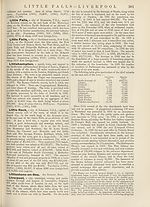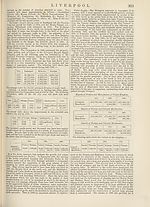New volumes of the Encyclopædia Britannica > Volume 30, K-MOR
(332) Page 302
Download files
Complete book:
Individual page:
Thumbnail gallery: Grid view | List view

302 LIVERPOOL
about 180 pictures, collected at the beginning of the 19th century
by William Roscoe, were deposited in the gallery.. They had for¬
merly been housed at the Royal Institution, Colquit Street.
Museums.—-Very extensive alterations in the structure and
arrangement of the William Rrown Museum have been undertaken.
The ground on which the building stands falls somewhat sharply
in a westerly direction, and the Corporation have extended the
galleries previously in existence by building an addition at the
west end equal in size to the whole of the previous museum and
library building as presented by Sir William Brown. By ex¬
cavating the slope from a face perpendicular to the west wall of
the old museum down to the level of Byrom Street (a thoroughfare
running north and south some fifty yards away at the foot of the
slope), accommodation has been found for a large central technical
school below the level of the museum, with an entrance from
Byrom Street distinct from the museum entrance. The former
levels in the museum are maintained, and the new galleries, which
are extended in a westerly direction over the technical school, fit
into the old, and together they form immense horse-shoe galleries,
each about 500 feet long by 85 feet wide ; and it is possible now to
arrange the magnificent collection in
the possession of the Corporation logic¬
ally and comprehensively, so that a
regular sequence of ideas may be
obtained. In addition to this, a fine
series of laboratories for biological in¬
vestigation has been constructed and
fitted with all the latest appliances, in
which original research may be carried
on, in addition to the usual dissection
for museum exhibits and the ordinary
mounting of specimens.
Municipal Technical Schools.—The
building for the Central Municipal
Technical School in Byrom Street, the
upper part of which, as stated above,
is devoted to museum galleries, was
opened in October 1901, the cost of the
building, exclusive of the site and
equipment, being over £112,000. The
Nautical College established by the
Corporation in 1892 is now carried on
in this building, which comprises a
small astronomical observatory in addi¬
tion to the usual lecture rooms, labora¬
tories, and workshops. The Corpora¬
tion have also built two branch
technical schools in the north and east
districts of the city, and conduct classes
also in other buildings which have
been adapted for the purpose in the
other districts.
Colleges and Schools. — University
College received its charter of incor¬
poration on the 18th October 1881, and
on the 15th November 1884 was ad¬
mitted as a college of the Yictoria Uni¬
versity. Since its foundation a sum of
upwards of £500,000 has been raised
by voluntary contribution, in addi¬
tion to £33,708 contributed by public
bodies. Twenty-seven chairs have been
endowed, and the university buildings
very largely extended. There are at
present 24 professors and 24 lecturers.
The average attendance of students in
1899-1900 amounted to 409 in the arts
and science and 154 in the medical
school. The number of students attend¬
ing evening classes amounted to 717.
Early in 1900 a supplemental charter
extended the powers of self-govern¬
ment, and brought the college into
close relations with the authorities of
the city and with local institutions, by
providing for their fuller representa¬
tion on the court of governors. The
authorities of the college are the presi¬
dent, the vice-presidents, the court of
governors, the council, the treasurer,
and the senate. The general manage¬
ment is conducted by the council,
which is composed of the president, the
vice-presidents, the treasurer, the prin¬
cipal and three professors of the college
chosen by the senate, fifteen persons
chosen by the court of governors, and
three persons chosen by the municipal
council. The School Board was intro¬
duced in 1870, and the first Board
elected on the 25th November in that
year. At that time the number of
scholars under the Board (average
attendance) amounted to 47,590, and the number of schools to 80.
The figures for the month of June 1901 were as follows :—32 per¬
manent and 18 temporary board schools, and 108 voluntary schools,
with an average attendance at the former of 41,855 and at the
latter of 64,440. During the year ending 30th June 1901 the
municipal expenditure was £128,000, while the various Government
grants amounted to £71,669.
Churches.—The various denominations have nearly all seen an
London • Stanftirdh Geog!Estab?
Plan of Liverpool.
about 180 pictures, collected at the beginning of the 19th century
by William Roscoe, were deposited in the gallery.. They had for¬
merly been housed at the Royal Institution, Colquit Street.
Museums.—-Very extensive alterations in the structure and
arrangement of the William Rrown Museum have been undertaken.
The ground on which the building stands falls somewhat sharply
in a westerly direction, and the Corporation have extended the
galleries previously in existence by building an addition at the
west end equal in size to the whole of the previous museum and
library building as presented by Sir William Brown. By ex¬
cavating the slope from a face perpendicular to the west wall of
the old museum down to the level of Byrom Street (a thoroughfare
running north and south some fifty yards away at the foot of the
slope), accommodation has been found for a large central technical
school below the level of the museum, with an entrance from
Byrom Street distinct from the museum entrance. The former
levels in the museum are maintained, and the new galleries, which
are extended in a westerly direction over the technical school, fit
into the old, and together they form immense horse-shoe galleries,
each about 500 feet long by 85 feet wide ; and it is possible now to
arrange the magnificent collection in
the possession of the Corporation logic¬
ally and comprehensively, so that a
regular sequence of ideas may be
obtained. In addition to this, a fine
series of laboratories for biological in¬
vestigation has been constructed and
fitted with all the latest appliances, in
which original research may be carried
on, in addition to the usual dissection
for museum exhibits and the ordinary
mounting of specimens.
Municipal Technical Schools.—The
building for the Central Municipal
Technical School in Byrom Street, the
upper part of which, as stated above,
is devoted to museum galleries, was
opened in October 1901, the cost of the
building, exclusive of the site and
equipment, being over £112,000. The
Nautical College established by the
Corporation in 1892 is now carried on
in this building, which comprises a
small astronomical observatory in addi¬
tion to the usual lecture rooms, labora¬
tories, and workshops. The Corpora¬
tion have also built two branch
technical schools in the north and east
districts of the city, and conduct classes
also in other buildings which have
been adapted for the purpose in the
other districts.
Colleges and Schools. — University
College received its charter of incor¬
poration on the 18th October 1881, and
on the 15th November 1884 was ad¬
mitted as a college of the Yictoria Uni¬
versity. Since its foundation a sum of
upwards of £500,000 has been raised
by voluntary contribution, in addi¬
tion to £33,708 contributed by public
bodies. Twenty-seven chairs have been
endowed, and the university buildings
very largely extended. There are at
present 24 professors and 24 lecturers.
The average attendance of students in
1899-1900 amounted to 409 in the arts
and science and 154 in the medical
school. The number of students attend¬
ing evening classes amounted to 717.
Early in 1900 a supplemental charter
extended the powers of self-govern¬
ment, and brought the college into
close relations with the authorities of
the city and with local institutions, by
providing for their fuller representa¬
tion on the court of governors. The
authorities of the college are the presi¬
dent, the vice-presidents, the court of
governors, the council, the treasurer,
and the senate. The general manage¬
ment is conducted by the council,
which is composed of the president, the
vice-presidents, the treasurer, the prin¬
cipal and three professors of the college
chosen by the senate, fifteen persons
chosen by the court of governors, and
three persons chosen by the municipal
council. The School Board was intro¬
duced in 1870, and the first Board
elected on the 25th November in that
year. At that time the number of
scholars under the Board (average
attendance) amounted to 47,590, and the number of schools to 80.
The figures for the month of June 1901 were as follows :—32 per¬
manent and 18 temporary board schools, and 108 voluntary schools,
with an average attendance at the former of 41,855 and at the
latter of 64,440. During the year ending 30th June 1901 the
municipal expenditure was £128,000, while the various Government
grants amounted to £71,669.
Churches.—The various denominations have nearly all seen an
London • Stanftirdh Geog!Estab?
Plan of Liverpool.
Set display mode to:
![]() Universal Viewer |
Universal Viewer | ![]() Mirador |
Large image | Transcription
Mirador |
Large image | Transcription
Images and transcriptions on this page, including medium image downloads, may be used under the Creative Commons Attribution 4.0 International Licence unless otherwise stated. ![]()
| Encyclopaedia Britannica > New volumes of the Encyclopædia Britannica > Volume 30, K-MOR > (332) Page 302 |
|---|
| Permanent URL | https://digital.nls.uk/193571817 |
|---|
| Attribution and copyright: |
|
|---|---|
| Shelfmark | EB.18 |
|---|---|
| Description | Ten editions of 'Encyclopaedia Britannica', issued from 1768-1903, in 231 volumes. Originally issued in 100 weekly parts (3 volumes) between 1768 and 1771 by publishers: Colin Macfarquhar and Andrew Bell (Edinburgh); editor: William Smellie: engraver: Andrew Bell. Expanded editions in the 19th century featured more volumes and contributions from leading experts in their fields. Managed and published in Edinburgh up to the 9th edition (25 volumes, from 1875-1889); the 10th edition (1902-1903) re-issued the 9th edition, with 11 supplementary volumes. |
|---|---|
| Additional NLS resources: |
|

